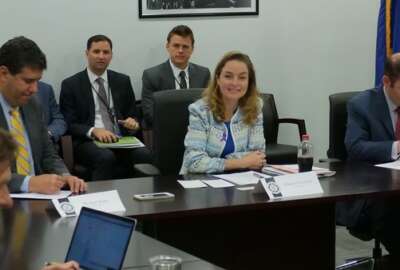
Are today’s college students prepared to fill the federal talent pipeline?
The Volcker Alliance is leading a series of discussions with colleges and universities across the country to develop best practices for preparing and recruiting...
Best listening experience is on Chrome, Firefox or Safari. Subscribe to Federal Drive’s daily audio interviews on Apple Podcasts or PodcastOne.
A series of statistics has worried agency leaders and human resources experts for the past few years: just 7 percent of today’s federal workforce is under the age of 30.

But that statistic has grown a little more worrisome recently, as the Office of Personnel Management now predicts at least 30 percent of federal employees will be eligible to retire within the next five years.
In the private sector, workers under 30 make up roughly 24 percent of the workforce.
OPM has been pushing agencies for the past several years to develop a more targeted approach to recruiting, as the time-to-hire across government crept up to 106 days in 2017.
But this year, the Volcker Alliance is leading an effort to find solutions to government’s hiring challenges at the start of the recruitment pipeline: colleges and universities.
These challenges drew Dustin Brown, deputy assistant director for management at OMB, to take a six-month sabbatical to lead the Volcker Alliance’s new “Government-to-University” initiative as a senior fellow. For the next few months, Brown and the Alliance will host conversations with students, faculty, administrators and other stakeholders from local, state and federal government to develop a series of best practices and new ideas to strengthen this pipeline from colleges and universities to public service.
The Alliance already held roundtable discussions at Carnegie Mellon University’s Heinz College of Information Systems and Public Policy in Pittsburgh, and it has three more stops planned at the University of North Carolina Chapel Hill School of Government, University of Kansas School of Public Affairs and University of Texas at Austin Lyndon B. Johnson School of Public Affairs.
The goal, Brown said, is to identify leading recruitment practices at the local level that can be scaled across government or that outside organizations like the Volcker Alliance can champion and develop networks of people and organizations that are committed to strengthening public sector institutions.
In addition, the Alliance wants to gain a greater sense of whether colleges and universities are preparing their students to join government — and whether federal agencies are recruiting and attracting young talent in the right way.
Though today’s graduating college students are generally prepared to enter the workforce, employers and organizations like the Volcker Alliance say there are some opportunities where the next generation has more to learn.
“Many of the soft-skills and business skills are really going to be most critical,” Brown said. “Written and verbal communication skills are among the top-ranked. Project and program management [and] change management skills are really going to be in high-demand. There are some areas like that where even the universities acknowledged there needs to be more done to prepare students for those types of skills, which are not just in demand in the public sector but also in the private sector.”
Agencies need to more actively recruit
The good news, Brown said, is that today’s college students are interested in public service. But they have more options than ever before serve.
“The challenge we have now is that there are so many different ways to serve, which is tremendous,” he said. “The non-profit sector, for instance, really has blossomed and more and more students see that as a great way of serving. Consulting firms work very closely with our federal agencies and that’s another way of serving.”
To compete, federal agencies need to “change the culture” of how they recruit top talent. College students find the current federal hiring process complex and burdensome, and agencies should spend more time visiting college campuses to form relationships with the university’s career services and faculty and teach students about their missions, Brown said.
“There was a real sense from the freshmen that we had at Carnegie Mellon that we have to move away from this idea that we post the job announcement and pray we get good talent applying,” he said. “We need to be much more actively recruiting. Every leading organization you see has that built into the expectations among their leadership and managers, and we need to do a much better job of that in the federal sector.”
Some agencies have an easier time than others conveying their mission to top talent. The Homeland Security Department, for example, has found success in displaying its “multi-faceted” brand through several onsite job fairs. The Defense Department has a clear, marketable mission.
Brown said the Alliance is working with Federal Executive Boards across to country to help a broad variety of federal, state and local agencies begin actively recruiting on college campuses.
“You never want to paint the entire federal government with one broad brush,” he said. “You do see certain agencies much more proactively recruiting and have a brand that’s really sought after. But that is not shared everywhere. There are a lot of agencies that do fall under the radar and aren’t as well known, but still have tremendous impact and tremendous opportunities.”
Copyright © 2024 Federal News Network. All rights reserved. This website is not intended for users located within the European Economic Area.
Nicole Ogrysko is a reporter for Federal News Network focusing on the federal workforce and federal pay and benefits.
Follow @nogryskoWFED





